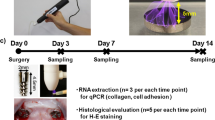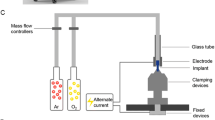Abstract
Copper (Cu) could serve as antibacterial coating for Ti6Al4V implants. An additional cell-adhesive layer might compensate Cu cytotoxicity. This study aimed at in vitro and in vivo evaluation of low-temperature plasma treatment of Ti6Al4V plates with Ti/Cu magnetron sputtering (Ti6Al4V–Ti/Cu), plasma-polymerized ethylenediamine (Ti6Al4V–PPEDA), or both (Ti6Al4V–Ti/Cu–PPEDA). Ti6Al4V–Ti/Cu and Ti6Al4V–Ti/Cu–PPEDA had comparable in vitro Cu release and antibacterial effectiveness. Following intramuscular implantation of Ti6Al4V–Ti/Cu, Ti6Al4V–PPEDA, Ti6Al4V–Ti/Cu–PPEDA and Ti6Al4V controls for 7, 14 and 56 days with 8 rats/day, peri-implant tissue was immunohistochemically examined for different inflammatory cells. Ti6Al4V–PPEDA had more mast cells and NK cells than Ti6Al4V, and more tissue macrophages, T lymphocytes, mast cells and NK cells than Ti6Al4V–Ti/Cu–PPEDA. Ti6Al4V–Ti/Cu had more mast cells than Ti6Al4V and Ti6Al4V–Ti/Cu–PPEDA. Results indicate that PPEDA-mediated cell adhesion counteracted Cu cytotoxicity. Ti6Al4V–Ti/Cu–PPEDA differed from Ti6Al4V only for mast cells on day 56. Altogether, implants with both plasma treatments had antibacterial properties and did not increase inflammatory reactions.



Similar content being viewed by others
References
Esposito M. Titanium for dental applications. In: Brunette DM, Tengvall P, Textor M, Thomsen P, editors. Titanium in medicine. Berlin: Springer; 2001. p. 172–230.
Campoccia D, Montanaro L, Arciola CR. The significance of infection related to orthopedic devices and issues of antibiotic resistance. Biomaterials. 2006;27:2331–9.
Arciola CR, Alvi FI, An YH, Campoccia D, Montanaro L. Implant infection and infection resistant materials: a mini review. Int J Artif Organs. 2005;28:1119–25.
von Eiff C, Arciola CR, Montanaro L, Becker K, Campoccia D. Emerging Staphylococcus species as new pathogens in implant infections. Int J Artif Organs. 2006;29:360–7.
Uçkay I, Pittet D, Vaudaux P, Sax H, Lew D, Waldvogel F. Foreign body infections due to Staphylococcus epidermidis. Ann Med. 2009;41:109–19.
Zhao L, Chu PK, Zhang Y, Wu Z. Antibacterial coatings on titanium implants. J Biomed Mater Res B Appl Biomater. 2009;91:470–80.
Stranak V, Wulff H, Rebl H, Zietz C, Arndt K, Bogdanowicz R, Nebe B, Bader R, Podbielski A, Hubicka Z, Hippler R. Deposition of thin titanium–copper films with antimicrobial effect by advanced magnetron sputtering methods. Mater Sci Eng C. 2011;31:1512–9.
Finke B, Hempel F, Testrich H, Artemenko A, Rebl H, Kylián O, Meichsner J, Biederman H, Nebe B, Weltmann KD, Schröder K. Plasma processes for cell-adhesive titanium surfaces based on nitrogen-containing coatings. Surf Coat Technol. 2011;205:S520–4.
Schlosser M, Wilhelm L, Urban G, Ziegler B, Ziegler M, Zippel R. Immunogenicity of polymeric implants: long-term antibody response against polyester (Dacron) following the implantation of vascular prostheses into LEW.1A rats. J Biomed Mater Res. 2002;61:450–7.
Xia Z, Triffitt T. A review on macrophage responses to biomaterials. Biomed Mater. 2006;1:R1–9.
Davis C, Fischer J, Ley K, Sarembock IJ. The role of inflammation in vascular injury and repair. J Thromb Haemost. 2003;1:1699–709.
Rodriguez A, Voskerician G, Meyerson H, Macewan SR, Anderson JM. T cell subset distributions following primary and secondary implantation at subcutaneous biomaterial implant sites. J Biomed Mater Res A. 2008;85:556–65.
Goodman SB. Wear particles, periprosthetic osteolysis and the immune system. Biomaterials. 2007;28:5044–8.
Tang L, Jennings TA, Eaton JW. Mast cells mediate acute inflammatory responses to implanted biomaterials. Proc Natl Acad Sci USA. 1998;95:8841–6.
Huss RS, Huddleston JI, Goodman SB, Butcher EC, Zabel BA. Synovial tissue-infiltrating natural killer cells in osteoarthritis and periprosthetic inflammation. Arthritis Rheum. 2010;62:3799–805.
Walschus U, Hoene A, Neumann HG, Wilhelm L, Lucke S, Lüthen F, Rychly J, Schlosser M. Morphometric immunohistochemical examination of the inflammatory tissue reaction after implantation of calcium phosphate-coated titanium plates in rats. Acta Biomater. 2009;5:776–84.
Hoene A, Walschus U, Patrzyk M, Finke B, Lucke S, Nebe B, Schröder K, Ohl A, Schlosser M. In vivo examination fo the inflammatory response against allylamine plasma polymer coated titanium implants in a rat model. Acta Biomater. 2010;6:676–83.
Kochanowski A, Hoene A, Patrzyk M, Walschus U, Finke B, Luthringer B, Feyerabend F, Willumeit R, Lucke S, Schlosser M. Examination of the inflammatory response following implantation of titanium plates coated with phospholipids in rats. J Mater Sci Mater Med. 2011;22:1015–26.
Stranak V, Cada M, Hubicka Z, Tichy M, Hippler R. Time-resolved investigation of dual high power impulse magnetron sputtering with closed magnetic field during deposition of Ti–Cu thin films. J Appl Phys. 2010;108:043305.
d′Agostino R. Plasma deposition, treatment and etching of polymers. Boston: Academic Press; 1990.
Liebermann MA, Lichtenberg AJ. Principles of Plasma Discharges and Materials Processing. 2nd ed. Hoboken: Wiley; 2005.
Stranak V, Wulff H, Bogdanowicz R, Drache S, Hubicka Z, Cada M, Tichy M, Hippler R. Growth and properties of Ti-Cu films with respect to plasma parameters in dual-magnetron sputtering discharges. Eur Phys J D. 2011;64:427–35.
Gallagher SR. Digital Image Processing and Analysis with ImageJ. Curr Protoc Essen Lab Tech. 2010;3:A.3C.1–.24.
Walschus U, Hoene A, Kochanowski A, Neukirch B, Patrzyk M, Wilhelm L, Schröder K, Schlosser M. Quantitative immunohistochemical examination of the local cellular reactions following implantation of biomaterials. J Microsc. 2011;242:94–9.
Kim J, Jung D, Park Y, Kim Y, Moon DW, Lee TG. Quantitative analysis of surface amine groups on plasma-polymerized ethylenediamine films using UV-visible spectroscopy compared to chemical derivatization with FT–IR spectroscopy, XPS and TOF-SIMS. Appl Surf Sci. 2007;253:4112–8.
Wilhelm L, Zippel R, von Woedtke T, Kenk H, Hoene A, Patrzyk M, Schlosser M. Immune response against polyester implants is influenced by the coating substances. J Biomed Mater Res A. 2007;83:104–13.
Schlosser M, Zippel R, Hoene A, Urban G, Ueberrueck T, Marusch F, Koch A, Meyer L, Wilhelm L. Antibody response to collagen after functional implantation of different polyester vascular prostheses in pigs. J Biomed Mater Res A. 2005;72:317–25.
Khouw IM, van Wachem PB, de Leij LF, van Luyn MJ. Inhibition of the tissue reaction to a biodegradable biomaterial by monoclonal antibodies to IFN-gamma. J Biomed Mater Res. 1998;41:202–10.
van Luyn MJ, Plantinga JA, Brouwer LA, Khouw IM, de Leij LF, van Wachem PB. Repetitive subcutaneous implantation of different types of (biodegradable) biomaterials alters the foreign body reaction. Biomaterials. 2001;22:1385–91.
Almeida CR, Vasconcelos DP, Gonçalves RM, Barbosa MA. Enhanced mesenchymal stromal cell recruitment via natural killer cells by incorporation of inflammatory signals in biomaterials. J R Soc Interface. 2012;9:261–71.
Vivier E, Tomasello E, Baratin M, Walzer T, Ugolini S. Functions of natural killer cells. Nat Immunol. 2008;9:503–10.
Dalbeth N, Gundle R, Davies RJ, Lee YC, McMichael AJ, Callan MF. CD56bright NK cells are enriched at inflammatory sites and can engage with monocytes in a reciprocal program of activation. J Immunol. 2004;173:6418–26.
Acknowledgments
We would like to thank Kirsten Tornow, Kathleen Arndt and Robert Mrotzek for their excellent technical support. This study was supported by the Federal Ministry of Education and Research (Grant No. 13N9779, Campus PlasmaMed).
Author information
Authors and Affiliations
Corresponding author
Additional information
Andreas Hoene and Maciej Patrzyk contributed equally to this study.
Rights and permissions
About this article
Cite this article
Hoene, A., Patrzyk, M., Walschus, U. et al. In vivo examination of the local inflammatory response after implantation of Ti6Al4V samples with a combined low-temperature plasma treatment using pulsed magnetron sputtering of copper and plasma-polymerized ethylenediamine. J Mater Sci: Mater Med 24, 761–771 (2013). https://doi.org/10.1007/s10856-012-4839-4
Received:
Accepted:
Published:
Issue Date:
DOI: https://doi.org/10.1007/s10856-012-4839-4




